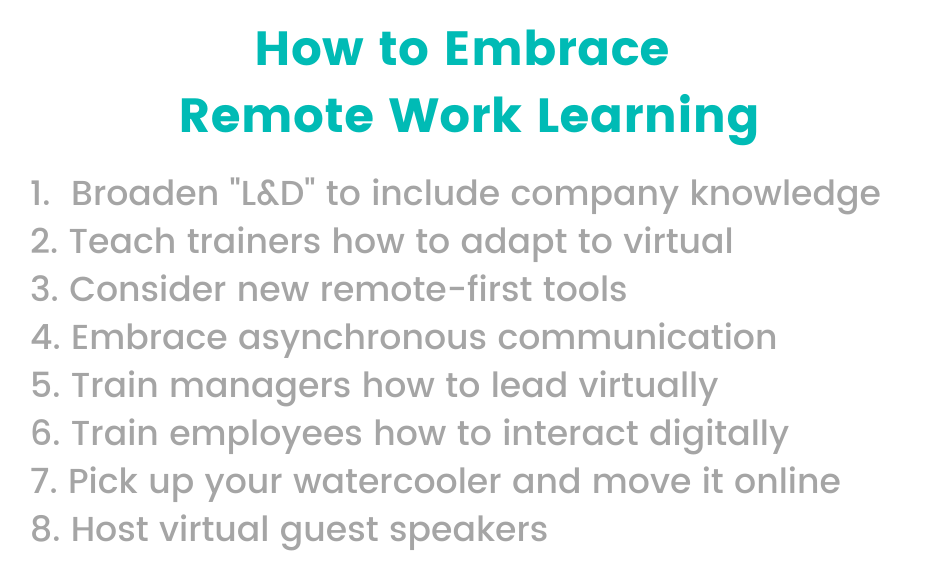8 Ways Startups Can Embrace Remote Learning
Learning and development (L&D) has evolved at a rapid pace — and things are changing even faster as companies begin to embrace remote work learning.
One hundred years ago, L&D was narrowly focused on improving efficiency on simple manual tasks like operating machinery. Then the field broadened to include in-person training for complex and dynamic jobs: sales, finance, etc.
In the past 10–20 years, L&D has further expanded to include aspects of employee engagement and retention as companies have realized that if they don’t train their employees, they’ll jump ship to another company that will help them develop necessary career skills.
Now, L&D is undergoing another massive shift as thousands of companies have transitioned to remote work. The new workplace learning looks much different than it did 20 years ago — before the ubiquity of fast wifi, screen-sharing software, and other digital tools. Employees are now signing on from Manila or Manhattan, São Paulo or San Francisco, leading to a more distributed workforce than our world has ever seen before.
A remarkable 75 percent of respondents to a recent Culture Amp survey are now working entirely remotely. And gazing into the future, the majority of survey respondents said that they plan to stay remote. Only 19 percent of the companies who took the survey plan to return to majority in-person work in the future.
Employees Are Feeling Disengaged
With this shift to remote work, PeopleOps teams across the globe are being forced to rethink their entire L&D strategy. Unfortunately, remote learning doesn’t just happen on its own, and remote employees are beginning to feel devalued and disconnected from their teams.
I know because I’ve been leading L&D in startups and SMBs for the past three years, and in my current role, I work with L&D leaders at over a dozen other companies.
In a 2020 study by Kahoot!, almost 50 percent of survey respondents said they believe L&D is more important to their success at work since they began working remotely. But even though this professional development is so important to employees, companies seem to be missing the mark of shifting their L&D strategy remote.
Forbes reported that there’s been a global decline in the past year in response to the statement, “I feel that I’m growing professionally.” The finding came from a 2020 survey by Peakon, which showed that employees in North America saw the greatest dip in this sentiment, and the youngest employees (Gen Z and Millennials) accounted for most of the negative sentiment.
So what does this mean for L&D? And what should PeopleOps teams and company executives do to embrace the new remote work learning reality?
These eight tips can help:

1. Broaden the definition of “L&D” to include company knowledge
Remember when most of your employees were in an office and could just absorb information by hearing their coworkers talk about what they were working on? That’s a luxury that most companies don’t have anymore. Lucinda Pullinger, global head of HR at The Instant Group, says, “Remote work makes it difficult for employees to ‘learn by osmosis.’”
That information employees used to overhear is more important than you might think. By knowing who is working on what projects, employees can develop greater understanding and empathy for other departments, understand the strategic direction of the company, and avoid duplicate work that happens when two people or teams don’t know they’re both trying to solve the same problem.
Each of these bits of internal company knowledge can contribute to higher levels of productivity, engagement, and connection. If you succeed at helping your employees learn the technical skills needed for their job but don’t teach them what they need to know about the rest of the business, they’ll end up “job-smart and company-dumb” — proficient in their individual tasks but completely disconnected from why their work is important, how it fits into the bigger picture, and who they need to talk to when working on cross-team initiatives.
2. Teach trainers how to adapt to a virtual environment
Leading a training via Zoom is way harder than leading one in-person. It’s much more difficult to read body language to see if your message is getting through to your learners, and it’s harder to convey energy through a 12-inch computer screen.
Because of this challenge, in past jobs, I’ve found it useful to coach my trainers about what changes they need to make for training in a virtual environment. Here are a few examples:
Let your passion come through the screen
Be animated. Yes, it’s weird to gesticulate and wave your arms in front of a computer screen, but it’s worth it because it helps the learner become more engaged and excited about the content you’re sharing.
Increase the amount of audience engagement
No one likes being talked at for an hour straight. That was bad enough in an in-person environment, but it’s a nightmare online. Try to double the number of times you ask questions to your learners. Give them more opportunities to engage. That will keep them from clicking away to check their inbox and it will also help them retain more of what you want them to remember.
Acknowledge the difficulty
I’ve found that it works really well to occasionally call out the awkwardness of remote learning. Tell your learners that you understand it’s tough to be seated in front of a screen for a long time. Explain the difficulties that you face as a trainer of not knowing whether your message is getting through and encourage them to stop you if anything doesn’t make sense. I’ve even found it useful to explain what I can and can’t see while I’m screensharing a training deck: “When I’m sharing my screen, I may not be able to see all of your faces, so please respond verbally rather than nodding your head.” The trainer and the learner co-create the learning experience. Help them help you create the best possible remote learning experience.
3. Consider new remote-first tools
As I mentioned above, learners find it difficult to sit in front of a screen all day. Zoom fatigue is real.
The best way to battle this fatigue is to be mindful of which trainings and development opportunities are best served with live training. It can be helpful to use live sessions for practicing skills and soliciting real-time feedback, but consider using screen-free options for priming information before training or sending out a “retention booster” afterward.
4. Embrace asynchronous communication and training
In their book Remote: Office Not Required, Basecamp co-founders Jason Fried and David Heinemeier Hansson write, “The big transition with a distributed workforce is going from synchronous to asynchronous collaboration. Not only do we not have to be in the same spot to work together, we also don’t have to work at the same time to work together.”
Basecamp has been a remote company for over 20 years, so they would know. Fried and Hansson view this as a feature — not a bug — of remote work, and it’s one of the things that comes along with the territory of allowing employees to work from anywhere.
While meetings are, by nature, synchronous, much company communication and training can (and should) be done asynchronously: email, Slack, recorded department updates, self-directed learning, recorded company trainings, you name it.
5. Train managers how to lead virtually
The manager role has always been a key bridge between upper leadership and the employee base. That bridge has become even more important as companies have made the shift to remote work.
I’ve heard countless companies talk about how they now rely on their managers more than ever to keep employees feeling engaged and connected. In other words, every dollar invested in manager development has a multiplier effect on your business. Prioritize manager training as one of your first (and biggest) L&D investments.
Managing an in-person team is fundamentally different than managing a virtual one, and your managers need to be trained on how to make this shift. In fact, a LinkedIn Learning study in mid-2020 found helping managers to be the number one learning challenge for L&D leaders in the coming months.
Here’s the full list of the top 5 challenges they found:
- Helping managers lead through change
- Keeping employees motivated and productive
- Transitioning in-person trainers into virtual trainers
- Meeting the emotional and psychological needs of employees
- Activating managers to support their teams
Managers who have never managed remotely often struggle to walk the line between staying up-to-date with what their people are doing and micromanaging their team’s work. It’s a tough balance.
Thankfully, there are loads of great resources out there about how to manage remotely from organizations like MIT, Inc., and Lattice. Curate a few of your favorite articles, then send them to managers. Get them talking about the challenges they’re facing with their remote teams. Consider hosting virtual lunch meetings for small groups of 3–5 managers to get together. Give them a platform for talking together and solving each other’s problems.
6. Train employees how to interact digitally
I’ve always been the type of person who preferred to talk things over in person rather than sending someone a Slack message. I know a lot of people who are the same way. If I had to solicit ideas from a colleague about a project or persuade a manager to do something, I just got up out of my chair and walked over to talk to the person. I trusted that my in-person powers of persuasion would carry the day — far beyond what I could convey in a typed message.
But many of us no longer have the luxury of in-person interaction, so more messages now must be conveyed via the written word through tools like email and slack. This means that writing skills are more important than they’ve ever been.
When’s the last time you hosted a writing class for your team? Probably never. I don’t blame you; it’s not top of mind for most L&D leaders. But improving your team’s writing skills can pay huge dividends when the vast majority of communication is happening over text. Consider hosting an optional company training on how to write clearly and concisely. Or recommend one or two articles to your team that contain writing and communication tips. Here are two of my favorites from Lattice and Hays.
7. Pick up your watercooler and move it online
Steve Jobs believed in the power of serendipitous collaboration: when colleagues bump into each other, they share ideas that spur further creativity. He even designed Pixar’s campus and Apple’s new Cupertino campus to create more opportunities for that serendipity.
But what happens to those serendipitous meet-ups as more companies shift to remote work? L&D leaders and company executives need to find ways to move those watercooler conversations online.
Whether through virtual coffee tools like Donut or by encouraging team members to schedule a recurring walking meeting on the phone with one of their mentors or close work friends, look for opportunities to help team members connect in ways that drive connection and inspire random brainstorming.
8. Host virtual guest speakers
One of the best ways to create a learning culture in your organization is to invest in L&D opportunities that are less directed to the bottom line. Rather than viewing every training as a way to increase business efficiency, show your people that you care about their personal development and growth by hosting a guest speaker who is a thought leader or respected author on a topic they care about.
Last year, I was able to book a bestselling personal finance author for a virtual talk for next to nothing. I had tried to schedule him for an in-person session last year, but the timing never worked out for him to fly out. Now that the world has gone remote, it’s much easier and cheaper to book people like that. And that remote session recorded the highest attendance of any guest speaker I’ve ever hosted. Your remote employees are craving growth. Give it to them.
The new world of remote work presents a lot of learning challenges as well as a lot of opportunities. Use the eight tips above to fully embrace this new remote learning reality, developing your team and hopefully increasing their level of engagement along the way.




